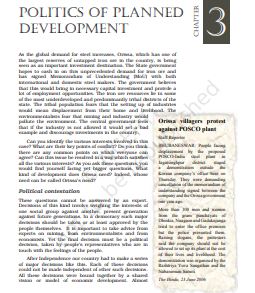‘NCERT Solutions for Class 12 Political Science Chapter 3‘ PDF Quick download link is given at the bottom of this article. You can see the PDF demo, size of the PDF, page numbers, and direct download Free PDF of ‘Ncert Class 12 Political Science Chapter 3 Exercise Solution’ using the download button.
NCERT Class 12 Political Science Textbook Chapter 3 With Answer PDF Free Download

Chapter 2: Politics of Planned Development
As the global demand for steel increases, Orissa, which has one of the largest reserves of untapped iron ore in the country, is being seen as an important investment destination.
The State government hopes to cash in on this unprecedented demand for iron ore and has signed a Memorandum of Understanding (MoU) with both international and domestic steel makers.
The government believes that this would bring in necessary capital investment and provide a
lot of employment opportunities.
The iron ore resources lie in some of the most underdeveloped and predominantly tribal districts of the state.
The tribal population fears that the setting up of industries would mean displacement from their home and livelihood. The environmentalists fear that mining and industry would pollute the environment.
The central government feels that if the industry is not allowed it would set a bad example and discourage investments in the country.
Can you identify the various interests involved in this case? What are their key points of conflict? Do you think there are any common points on which everyone can agree?
Can this issue be resolved in a way that satisfies all the various interests? As you ask these questions, you would find yourself facing yet bigger questions.
What kind of development does Orissa need? Indeed, whose need can be called Orissa’s need?
These questions cannot be answered by an expert. Decisions of this kind involve weighing the interests of one social group against another, present generation against future generations.
In a democracy, such major decisions should be taken or at least approved by the people themselves.
It is important to take advice from experts on mining, environmentalists, and economists.
Yet the final decision must be a political decision, taken by people’s representatives who are in touch with the feelings of the people.
After independence, our country had to make a series of major decisions like this. Each of these decisions could not be made independent of other such decisions.
All these decisions were bound together by a shared vision or model of economic development.
| Author | NCERT |
| Language | English |
| No. of Pages | 18 |
| PDF Size | 1.1 MB |
| Category | Political Science |
| Source/Credits | ncert.nic.in |
NCERT Solutions Class 12 Political Science Chapter 3 Politics of Planned Development
1. Explain any two merits and two demerits each of the Green Revolution.
Answer: Two Merits of the Green Revolution:
(i) The Green Revolution ensured food sufficiency in the country. In many parts, the stark contrast between the poor peasantry and the landlords produced conditions favorable for left-wing organizations to organize the poor peasants.
(ii) The Green Revolution resulted in the rise of middle peasant sections.
These were farmers with medium size holding, who benefited from the changes and soon emerged politically influential in many parts of the country.
Two Demerits of the Green Revolution:
(i) The Green Revolution delivered only moderate agricultural growth and raised the availability of food in the country but also increased polarisation between classes and regions.
(ii) Some regions like Punjab, Haryana, and Western UP became agriculturally prosperous while others remained backward.
2. List any two merits and two demerits of the Green Revolution.
Or
What is Green Revolution? Highlight any two of its effects?
Answer: Green Revolution was introduced to bring about revolutionary changes in agriculture especially in foodgrains like wheat and rice to increase production:
1. Production was increased by the use of high-yielding varieties of seeds.
2. Scientific irrigation and fertilizers were also applied.
Merits of Green Revolution:
(а) The government offered various irrigational facilities at subsidized prices.
(б) It resulted in the rise of the ‘Middle Peasant Section’ who soon emerged politically influential.
Demerits of Green Revolution:
(a) This created a stark contrast between the poor peasantry and the landlords.
(b) It increased polarisation between the classes and regions like northern states i.e. Punjab, Haryana, and West UP, which became agriculturally rich but others remained backward.
3. How was the Planning Commission of India: set up? Mention its scope of work.
Answer: Planning Commission was set up as:
1. It consists Prime Minister as its chairman.
2. Some ministers are in charge of economic portfolios.
3. The members of the planning commission have a high public image along with an administrative and educational background.
Its scope of work:
1. To bring socio-economic change.
2. It was to provide a controlled and faster growth rate.
3. To resolve contradictions between societies.
4. describe the main functions of the planning commission of India.
Answer: The planning commission was set up in 1950 by a cabinet resolution as an extra-constitutional body:
1. It looks advisory in nature but it is very powerful to be known as an economic cabinet of the country.
2. Planning commission prepares a document to have a plan for income and expenditure for five-year plans.
3. Planning commission prepares strategies to provide adequate means of livelihood for every man and woman.
4. It also ensures not to concentrate wealth and means of production into a few hands only.
Politics of Planned Development NCERT Textbook With Solutions PDF Free Download
